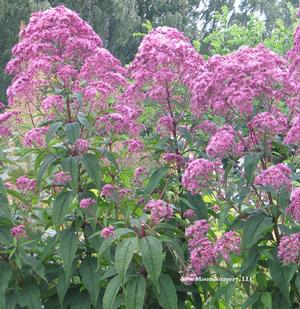New Moon Nurseries
Eupatorium purpureum
Sweet Joe pye weed
Native to North America
FIRST IMPRESSIONS: Eupatorium purpureum is a large clumping perennial that injects architectural interest into the late summer landscape. This robust wildflower has multiples of sturdy stems with whorls of attractive foliage. In mid-summer, plants are topped with a frothy crown of rounded rosy pink flower clusters. The vanilla scented blooms are frequented by butterflies. This species thrives in sunny or partly shaded sites in dry or moist soils.
HABITAT & HARDINESS: Eupatorium purpureum occurs in North America in Ontario and from Maine to Florida and west to Minnesota and Oklahoma.
Plants are indigenous to low open woods, dry wooded slopes, rich calcareous woodlands, savannas, lightly shaded river banks and seeps, thickets, edges of woodlands and bottomland forests. Plants tolerate shade but tend to decline as the canopy matures and shade becomes denser.
This species is hardy from USDA Zones 4-8.
PLANT DESCRIPTION: Eupatorium purpureum is an upright perennial with sturdy unbranched stems. The stems are green and smooth except for purple coloration at the nodes where leaf whorls originate.
There are usually 4-5 leaves in each whorl. The leaves are lanceolate, toothed and 6-12” long
From mid-summer until autumn, plants bear terminal dome shaped flower corymbs that average 10” across. The flower clusters consist of many small feathery lavender-pink disc florets.
The blossoms mature into soft buff colored seed clusters that are attractive into the winter.
Plants are 4-7’ tall with a 3-4’ spread.
CULTURAL & MAINTENANCE NEEDS: Eupatorium purpureum prefers part sun to light shade. Plants tolerate full sun and full shade and thrive in moist mesic loams or well drained rich soils.
This is the most shade and drought tolerant of the Joe Pye weeds. Plants also adapt to clay and alkaline soils.
This species is pest resistant and foliage is unpalatable to deer and other herbivores.
LANDSCAPE USES: Eupatorium purpureum is a dramatic Accent for a Wildlife Garden or moist Meadow. Plants are also used as Butterfly Nectar Plants, Cut Flowers or as part of a Grouping or Mass Planting. This wildflower has Showy Blooms and provides Erosion Control. It can be used in Cottage Gardens, Deer Resistant Plantings, Rain Gardens, Water-wise Landscapes, Low Maintenance Plantings or Perennial Borders.
COMPANION & UNDERSTUDY PLANTS: Try pairing Eupatorium purpureum with Aster novae-angliae, Lobelia siphilitica, Monarda fistulosa, Rudbeckia laciniata,, Solidago rugosa ‘Fireworks’, Carex amphibola or Sorghastrum nutans.
Eupatorium maculatum and Eupatorium fistulosum are worthy substitutes as they are tall plants with similar flowerheads, whorled leaves and comparable cultural requirements.
TRIVIA: The fragrant flowers attract butterflies, skippers, moths and native bees. Moths of several caterpillars feed on the foliage.
The Latin name of this species has been changed to Eutrochium purpureum. Generally the former Eupatorium spp. with whorled leave are now Eutrochium spp. and the bonesets or thoroughworts which have opposite leaves are still classified as Eupatorium spp.
Eupatorium purpureum differs from the other Joe Pyes due to its fragrant dome shaped flower clusters and solid stems that are mostly green except for purple blotches at the nodes. E. maculatum has flat toped flower clusters and stems that are either purple spotted or solid purple. E. fistulosum has dome shaped flower clusters that are not noticeably fragrant and stems that are hollow and usually just green.
Height:
4-7 ftSpread:
2-3 ftSpacing:
4-6 ftUSDA Hardiness Zone:
4-8Bloom Color:
PurpleEupatorium purpureum Characteristics
Attracts Wildlife
- Butterflies
- Songbirds
- Pollinators
Attributes
- Dried Flower
- Cut Flower
- Rain Garden
- Clay Soil
- Naturalizing
- Bog
- Long Blooming
- East-Coast Native
- Drought Tolerant
Exposure
- Full Sun to Partial Shade
Flowering Months
- September
- August
- July
Foliage Color
- Green
Juglans nigra Tolerance (Black Walnut)
- Yes
Soil Moisture Preference
- Wet to Moist
Interesting Notes:
For more information on this plant, visit the USDA PLANTS Database: http://plants.usda.gov/java/profile?symbol=EUPUH2
